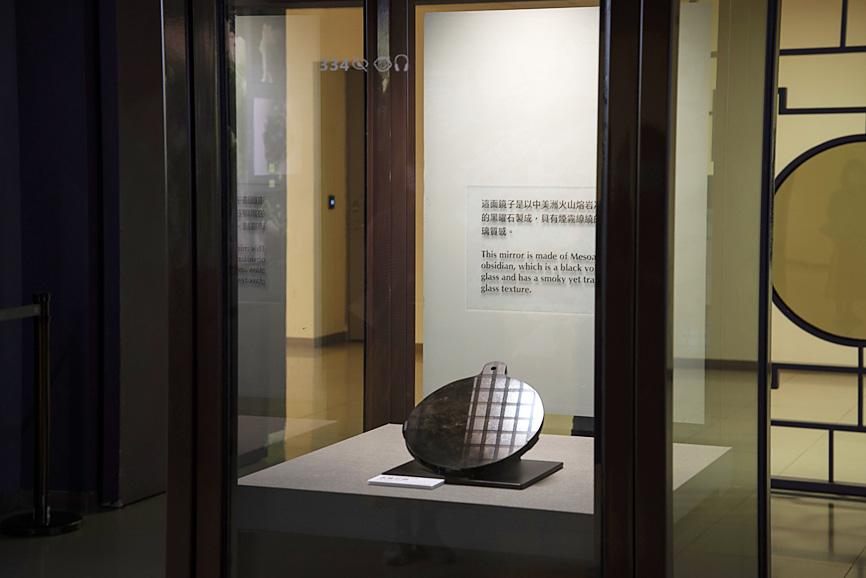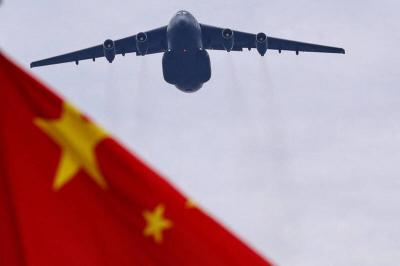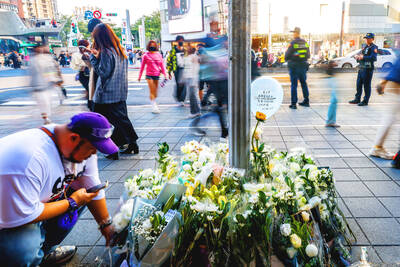An exhibition that opened yesterday at the National Palace Museum in Taipei features a 400-year-old obsidian mirror associated with the Aztec deity Tezcatlipoca.
The mirror is being displayed in Exhibition Room 302, the museum said on Monday.
It was taken from Mesoamerica following the region’s conquest by Spain and found its way to the court of the Qing Dynasty through European missionaries, it said.

Photo courtesy of the National Palace Museum via CNA
The exhibition contains correct and updated information about the artifact, the museum said.
Emperor Shunzhi (順治), the first Qing emperor, attempted to identify the mineral used in the mirror to no avail, it said.
Later Qing emperors Qianlong (乾隆) and Daoguang (道光) wrote songs and poetry in praise of the mirror, showcasing its value within the court, it added.
The Qing court even had a protective pouch made for the mirror, the museum said, adding that the pouch is being displayed alongside the mirror at the exhibition.
As the function, properties and name of the mirror were unknown to the Qing court, it was called the “Ink-Jade Mirror.” The museum retained the name for some time before renaming the piece the “Ink-Crystal Mirror” in its first modern update.
Researchers at the museum have since confirmed that the artifact is a rare obsidian mirror from the Mesoamerican Aztec culture fashioned from the naturally occurring volcanic mineral.
This has resulted in the piece being renamed again to “Aztec Obsidian Mirror” from the Qing imperial collection, the museum said.
Mirrors were important relics in the mystic traditions of Mesoamerican cultures, as they were believed to be portals to intangible realms, such as the past and the future, the museum said.
The mirror is traditionally associated with the god Tezcatlipoca, often representing a wide range of concepts, including the night sky, night winds, the jaguar, sorcery, war and conflict, it said.
Other obsidian mirrors also found their way to European collectors following the fall of the Aztec Empire, the most famous of which belonged to John Dee, an astronomer, occultist and alchemist at the court of Queen Elizabeth I.

Beijing could eventually see a full amphibious invasion of Taiwan as the only "prudent" way to bring about unification, the US Department of Defense said in a newly released annual report to Congress. The Pentagon's "Annual Report to Congress: Military and Security Developments Involving the People's Republic of China 2025," was in many ways similar to last year’s report but reorganized the analysis of the options China has to take over Taiwan. Generally, according to the report, Chinese leaders view the People's Liberation Army's (PLA) capabilities for a Taiwan campaign as improving, but they remain uncertain about its readiness to successfully seize

HORROR STORIES: One victim recounted not realizing they had been stabbed and seeing people bleeding, while another recalled breaking down in tears after fleeing A man on Friday died after he tried to fight the knife-wielding suspect who went on a stabbing spree near two of Taipei’s busiest metro stations, Taipei Mayor Chiang Wan-an (蔣萬安) said. The 57-year-old man, identified by his family name, Yu (余), encountered the suspect at Exit M7 of Taipei Main Station and immediately tried to stop him, but was fatally wounded and later died, Chiang said, calling the incident “heartbreaking.” Yu’s family would receive at least NT$5 million (US$158,584) in compensation through the Taipei Rapid Transit Corp’s (TRTC) insurance coverage, he said after convening an emergency security response meeting yesterday morning. National

Taiwan has overtaken South Korea this year in per capita income for the first time in 23 years, IMF data showed. Per capita income is a nation’s GDP divided by the total population, used to compare average wealth levels across countries. Taiwan also beat Japan this year on per capita income, after surpassing it for the first time last year, US magazine Newsweek reported yesterday. Across Asia, Taiwan ranked fourth for per capita income at US$37,827 this year due to sustained economic growth, the report said. In the top three spots were Singapore, Macau and Hong Kong, it said. South

PLANNED: The suspect visited the crime scene before the killings, seeking information on how to access the roof, and had extensively researched a 2014 stabbing incident The suspect in a stabbing attack that killed three people and injured 11 in Taipei on Friday had planned the assault and set fires at other locations earlier in the day, law enforcement officials said yesterday. National Police Agency (NPA) Director-General Chang Jung-hsin (張榮興) said the suspect, a 27-year-old man named Chang Wen (張文), began the attacks at 3:40pm, first setting off smoke bombs on a road, damaging cars and motorbikes. Earlier, Chang Wen set fire to a rental room where he was staying on Gongyuan Road in Zhongzheng District (中正), Chang Jung-hsin said. The suspect later threw smoke grenades near two exits